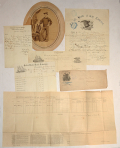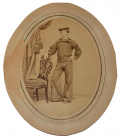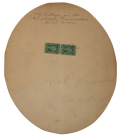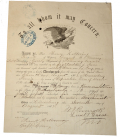site search
online catalog
HENRY W. KETTERING GROUP: PENNSYLVANIA CAVALRY AND U.S. NAVY
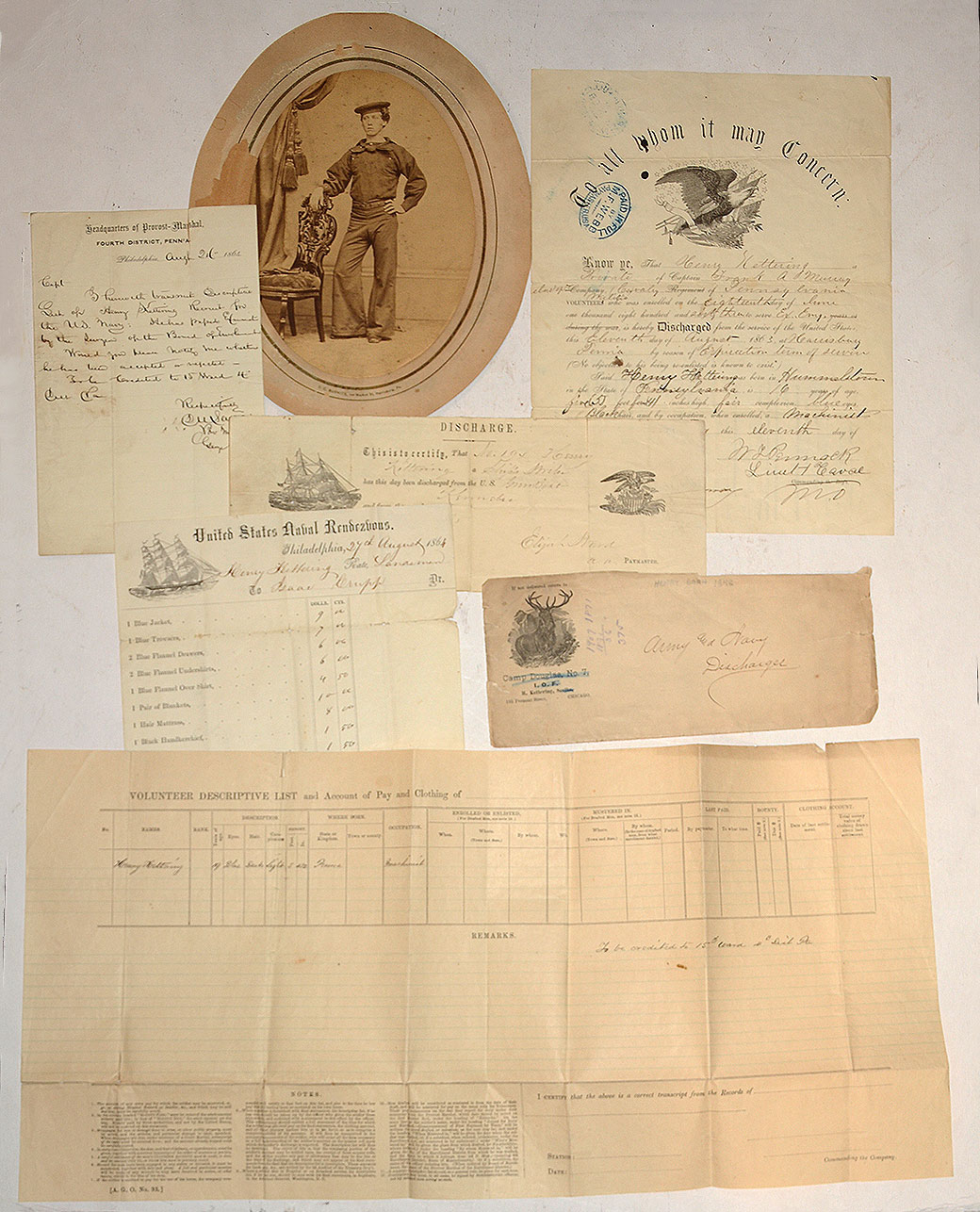
$450.00 ON HOLD
Quantity Available: 1
Item Code: 1179-1331
Formerly in the collections of the Texas Civil War Museum, this grouping of US Navy material relates to a sailor serving aboard the USS Kennebec, which did blockade duty off the Texas coast and was involved in one of the last captures of a blockade runner, the “Denbigh” on May 24, 1865, a ship that had eluded capture for some time. The centerpiece of the group, seven items in all, is a nicely posed full-standing, large albumen photograph of Henry Kettering in full navy enlistedman’s uniform, and is accompanied by Kettering’s 1863 discharge from prior military service in Murray’s Independent Company of Pennsylvania Cavalry in the Emergency Militia, recruited during the Gettysburg campaign, his “descriptive list” from his enlistment in the U.S. Navy, his list of issued clothing at the Naval Rendezvous in Philadelphia, a letter from a district Provost Marshal’s office seeking clarification on his status so that his enlistment might be credited to his ward, and his discharge from the navy at the end of his year’s enlistment with service on the gunboat Kennebec. The paperwork was contained in an envelope with it bearing the printed return address of Chicago camp of the Independent Order of Foresters, a fraternal benevolent association, with Kettering listed as the camp’s “scribe,” presumably secretary.
The albumen image is very clear with just some tiny, thin age foxing. It is oval, on a bordered oval mat with some paper adhering to the mat at left, likely from another mat when framed. Kettering is shown full standing, wearing his dark blue seaman’s blouse with neckerchief, navy cap tilted slightly and showing its knotted cap band at the side, and wearing a pair of navy issue dark bellbottom trousers. He is posed trying to look casual, one hand on hip, the other resting on the back of an ornate studio chair, with the studio drapery and tassels visible at left and just the tip of the base of the head clamp at bottom right. The mount is stamped “D.C. Burnite, 110 Market St. Harrisburg, Pa.” The reverse has two cancelled, green three-cent tax stamps, a photographer’s note in pencil at bottom “oval frame / Black” and a very nice, later, ink notation at top: “My Father on the / ‘Gunboat Kennebec’ / Civil War.”
His prior military service is recorded on an Army “eagle” discharge dated Aug. 11, 1863, indicating he had enlisted June 18, 1863, to serve “Ex. Emg.,” the extent of the emergency, or under the emergency call we presume. The unit was organized under Gov. Curtin’s call for militia during the state of emergency called during Lee’s invasion in the Gettysburg campaign, and was commanded by Captain Frank A. Murray. Some 97 men strong, it was also known as the “Curtain Guard” and did have some encounters with Confederates: six members were taken prisoner at the Stone Tavern in Cumberland County and at Mechanicsburg, and were paroled by Early’s Provost Marshal on June 30 at Carlisle. Kettering was mustered out on Aug. 11, 1863, the date of muster out of the unit as a whole.
He is described as having been born in Hummelstown, standing 5’4” tall, with fair complexion, blue eyes, black hair, and was a machinist by occupation. His age is given as 16, though the 1900 census lists his birthdate as December 1848, which would have made him just 15. When he signed up in the Navy little more than a year later, on Aug. 26, 1864, he apparently had aged considerably, listing himself then as 19, but with other details unchanged. He seems to have gone into service rated as a Landsman, pretty much the bottom of the pile, but was rated as a Ship’s Writer on discharge on Aug. 10, 1865, which was a petty officer of the staff. This would fit his office in the I.O.F. as “scribe” and his profession in 1900 as bookkeeper. He was discharged from the US Gunboat Kennebec. His pension card indicates service on the Princeton, VT (presumably the Vermont,) Wabash and Memphis as well.
His exact dates of service on each vessel are unclear but the Princeton and Vermont were receiving and stores ships; His first real sea duty was thus likely aboard the others. Wabash was a steam frigate in the North Atlantic Blockading Squadron and in the attack on Ft. Fisher; Memphis was a captured and converted blockade runner serving in the South Atlantic Blockading Squadron and operating around Charleston; the Kennebec had seen action at Mobile Bay under Farragut in August 1864, underwent repairs at Pensacola until March 10, 1865, when it was sent to blockade duty off the Texas coast, helping to destroy the blockade runner Denbigh on May 24, 1865. The vessel continued on duty off the coast until sailing on July 6, 1865, to Pensacola and then north. Our best guess is that Kettering was aboard during that phase of the vessel’s service.
Kettering later married Lydia Felger and their first child was born in Pennsylvania in 1871, but the rest (totaling five sons and two daughters in all) were born in Illinois beginning in 1873. It was one of those children who annotated the reverse of the photo of their father.
He died in Chicago in 1912. She passed away in 1931. One of their sons was killed in action in France in August 1918. [sr][ph:L]
~~~~~~~~~~~~~~~~~~~~~~~~~~~~~~~~~~~
THIS ITEM, AS WITH ALL OTHER ITEMS AVAILABLE ON OUR WEB SITE,
MAY BE PURCHASED THROUGH OUR LAYAWAY PROGRAM.
CLICK HERE FOR OUR POLICIES AND TERMS.
THANK YOU!
Inquire About HENRY W. KETTERING GROUP: PENNSYLVANIA CAVALRY AND U.S. NAVY
For inquiries, please email us at [email protected]
Most Popular
Historical Firearms Stolen From The National Civil War Museum In Harrisburg, Pa »
Theft From Gravesite Of Gen. John Reynolds »
Selection Of Unframed Prints By Don Troiani »
Fine Condition Brass Infantry Bugle Insignia »
Wonderful Condition Original Confederate-Manufactured Kepi For A Drummer Boy Or Child »
featured item
RARE CONFEDERATE CAVALRY GUIDON
This Confederate guidon comes from the collections of the Texas Civil War Museum. The flag has been professionally conserved, matted, and framed by Textile Preservation Associates and comes with their 1995 letters of examination, treatment, and… (1179-027A). Learn More »
site search
Upcoming Events
The shop will remain closed to the public through Friday, Jan. 24th, re-opening on Saturday, Jan.… Learn More »



